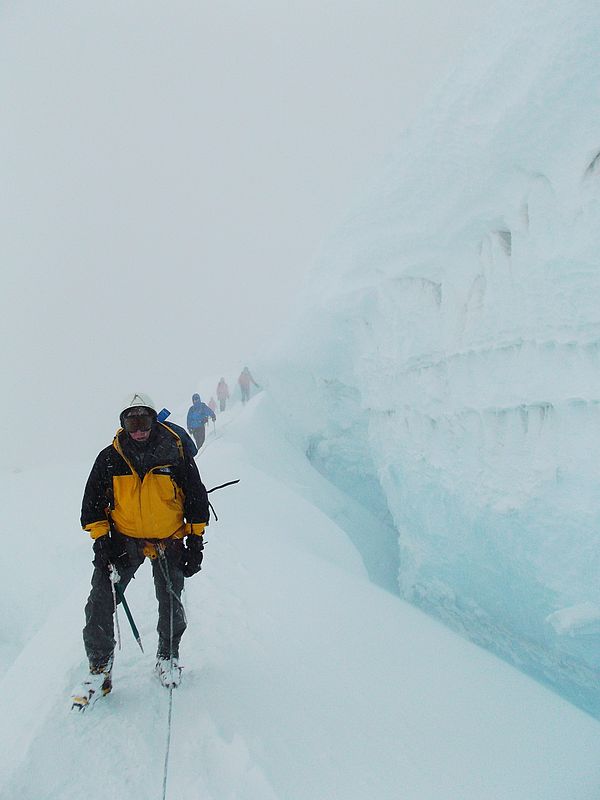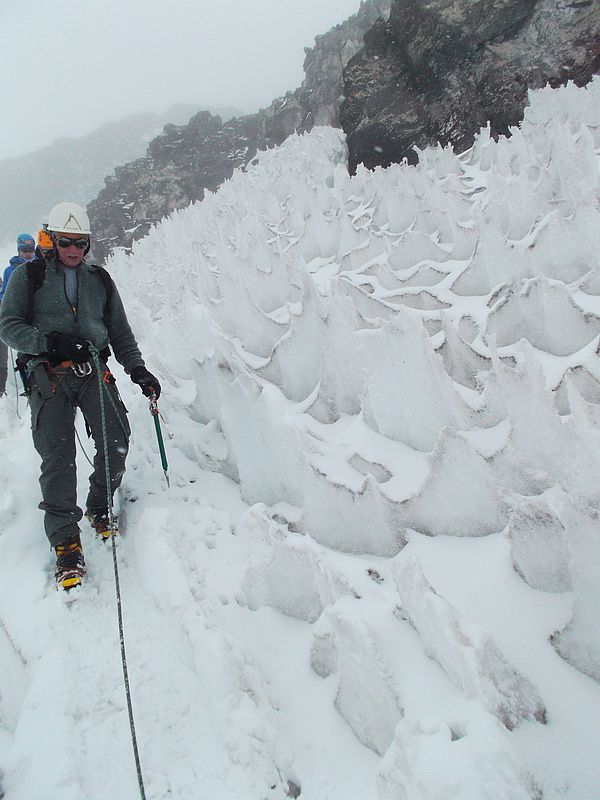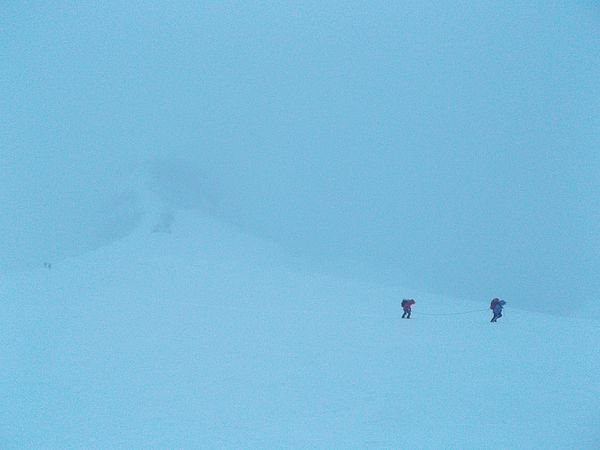I had the opportunity to see Mount Rainier's summit on June 23rd with a team of intrepid climbers, despite damp and diminishing conditions.
Here are some notes regarding the current climbing conditions:
- The summer season has begun as a moist one, with continued "spring conditions". Things on the Muir Snowfield up to Camp Muir (10K) are pretty normal and the route is well-wanded. As the summer season melt progresses, please do your best to find the trail in between the snow melt-outs, so as to preserve the beauty of the alpine meadows.
- From Camp Muir, the route traverses at the usual elevation across the Cowlitz Glacier and into Cathedral Gap. The Gap is now a mix of snow and rock, with several switchbacks on the way up. Taking your time to choose the appropriate rock trail to connect the smoother travel of the snow sections will save you time (and prevent rock fall on parties below). The mix of snow and rock continues as you approach Dunns Roll. As you step onto the Ingraham Glacier there are several cracks forming before getting to the relatively crevasse-free camp area at 11K.
- From the Ingraham Flats camp area, the line cruises up above the "High Crack", then traverses beneath the serac area of the Ingraham Glacier. Efficient team travel here is necessary to minimize exposure to potential ice fall; this is also the case when entering onto the "Nose" of the Cleaver. The current entry onto the Cleaver is the higher one of the two typical entry points. Along the entry to the Cleaver and then as you start up the spine there are several "fixed" lines. These lines are neither necessarily fixed or necessary--the anchors have melted out substantially and the trail is established enough that confident climbers will find no need for additional security.
- As you head up the Cleaver the route offers the opportunity to go out onto the near shoulder, traversing up several snow switchbacks. This is definitely more preferable than trying to head directly up the rocky spine of the Cleaver. Whatever route you do choose though, be a responsible climber and use short rope intervals that minimize rock fall, allow for efficient travel, and increases the security of your own team in the event of a fall (there are no crevasses on the Cleaver, so long intervals are unnecessary). During our ascent, the Cleaver was strifed with interesting "penitente" snow-spike formations (see photo) that would make it almost impossible to slide in the event of a fall; however, snowfall on June 24-25 may be filling those in.
- Above the Cleaver is where the route gets more unique and interesting currently. Thanks to the hard work of several guides, last week a new--and quite unusual--route was established above the Cleaver. Typically, the route heads up from the Cleaver and then traverses towards the Emmons Glacier. That route was becoming increasingly broken up last week, to the point where the several ladders in place were no longer enough. Guide teams instead established a route that crosses the Ingraham Glacier, heading toward "Camp Comfort" at the top of the Gibraltar Ledges. This is reportedly the first time in about a decade that this route has been in use and it is an interesting one. Nearing Camp Comfort there is a spine of ice that offers something of a knife-edge traverse (see photo). Again, here you may see "fixed" lines, but--again--considering the quality of what they are anchored to and the relative smoothness of the trail they are not necessary for confident climbers (they may in fact now be buried in new snow anyway).
Connect with me if you'd like a GPS file with the route (can't be attached here).
Some additional important info:
- The route is very well wanded, the problem in low visibility would be that some wands exist of earlier routes. Pay attention to double wanding (indicating hard turns), "X"ed wands (indicating don't go that way) and use your mountain sense. Make sure you are up to speed on your navigation skills and don’t just rely on “connecting the dots.”
- If you choose to use any fixed lines, before grabbing hold and thinking you're good to go, ask yourself "Fixed by whom?" and "Fixed when?" Snowmelt quickly renders a solid anchor placement into a pile of slush. If you assess the lines and determine they are suitable for use, PLEASE make sure you are familiar with systems for doing so efficiently--the potential for log-jamming other parties is HUGE if you don’t. Typically a simple hand line is very suitable. If you feel you need to clip in, use an ascender or Tibloc, not a friction hitch--which take forever to make and tear down--and make sure your team has “gone short” (shortened intervals between climbers) before getting on the lines. If you don't do this, you will slow many other parties down and jeopardize everyone's attempt at a safe summit.
- The Cleaver is always a place where rockfall is a hazard. PLEASE minimize that hazard for other parties by traveling carefully and by using appropriate short intervals while on the Cleaver. If you are unclear about how to quickly transition from long, glacier appropriate, intervals to short, steep terrain, appropriate intervals you would be well-advised to seek out the training to add this technique to your repertoire.
- Similarly, if the freezing level rises above 11,000' you should be increasingly aware of rockfall hazards. Plan your ascent departure time accordingly and be prepared to turn around higher on the mountain if the day is getting long, as the warm daytime temps increase rockfall potential.
- Since the June 23rd summit there is new snow on the mountain. Stay aware of snow stability concerns.
As always, you can find more pictures of the current route at the Adventure Spirit Rock + Ice + Alpine Experiences Facebook site.
Mountain conditions are subject to quick changes and the conditions reported above are one subjective view. The information provided above is only one small piece of information you need to use in you and your team's overall decision-making process.
Some other helpful links to aid you in making the best decision for you and your team can be found at:
- Rainier Mountaineering Incorporated's route updates -- http://www.rmiguides.com/rainier/route_info.php
- Rainier Specific Weather Forecast-- http://www.atmos.washington.edu/data/rainier_report.html
- Rainier Weather History (Telemetry) -- http://www.nwac.us/weatherdata/campmuir/now/
- Avalanche Safety-- http://www.nwac.us/forecast/avalanche/current/zone/7/
- NPS Ranger Rainier Blog-- http://mountrainierclimbing.blogspot.com/



